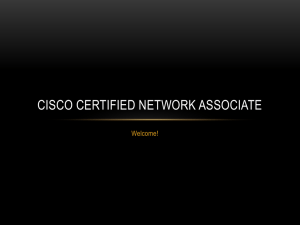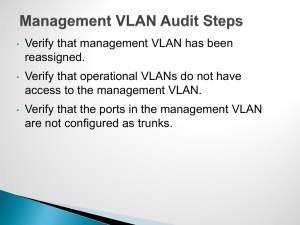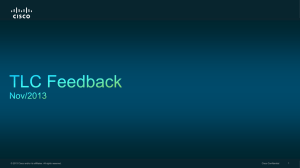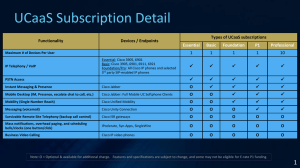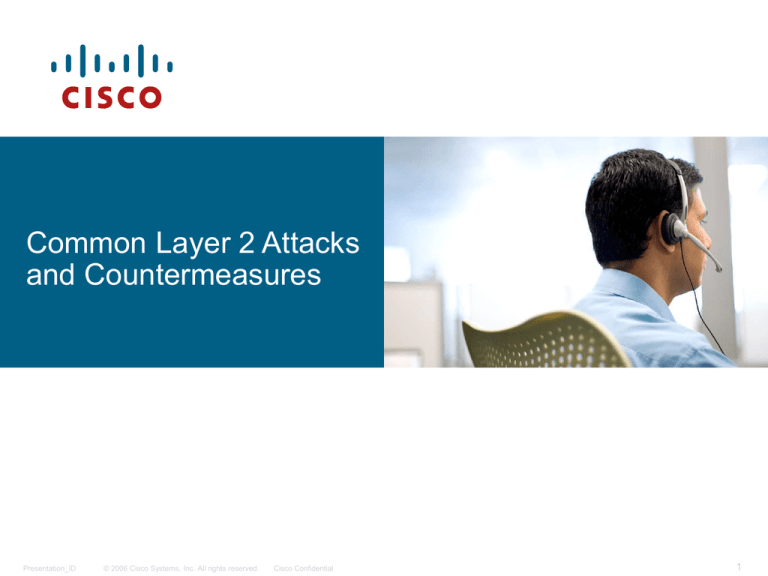
Common Layer 2 Attacks
and Countermeasures
Presentation_ID
© 2006 Cisco Systems, Inc. All rights reserved.
Cisco Confidential
1
Agenda
VLAN Attacks and Security
VLAN Hopping
VTP
STP
Other
Layer 2 Attacks and Security
MAC
DHCP
ARP
Spoofing
Other
Presentation_ID
© 2006 Cisco Systems, Inc. All rights reserved.
Cisco Confidential
2
VLAN Attacks
and Security
Presentation_ID
© 2006 Cisco Systems, Inc. All rights reserved.
Cisco Confidential
3
VLAN Hopping
Dynamic Trunking Protocol
Manually configure trunk and access ports, don’t rely on default
dynamic port configuration
CLI: switchport mode trunk, switchport mode access
Presentation_ID
© 2006 Cisco Systems, Inc. All rights reserved.
Cisco Confidential
4
VLAN Hopping
Double Tagging 802.1q frames
Presentation_ID
© 2006 Cisco Systems, Inc. All rights reserved.
Cisco Confidential
5
VLAN Hopping
Clear unnecessary VLANs on the trunk
switchport trunk allowed vlan 10,11,12
switchport trunk allowed vlan remove 10,12
Don’t use trunk native VLAN anywhere else
switchport trunk native vlan 999
Set trunks to 802.1q All Tagged mode
vlan dot1q tag native
Presentation_ID
© 2006 Cisco Systems, Inc. All rights reserved.
Cisco Confidential
6
VTP Security
VTP automatically hands out domain name and VLAN
information to VTP server and VTP clients
VTP server not regulated, VTP server with highest
revision number is ‘boss’
Use VTP transparent or VTP Server/Client with domain
name and passwords
Presentation_ID
© 2006 Cisco Systems, Inc. All rights reserved.
Cisco Confidential
7
Port Settings
If a port is connected to a ‘foreign’ device disable layer 2
protocols (CDP, DTP, PAgP, UDLD)
switchport host
switchport nonegotiate
Enable spanning-tree portfast with BDPU guard and/or
root guard, use RPVST+
spanning-tree bpduguard
spanning-tree guard root
Presentation_ID
© 2006 Cisco Systems, Inc. All rights reserved.
Cisco Confidential
8
Other VLAN Security
Private VLANs
VACLs
Dynamic VLAN assignment
802.1x (Identity based networking)
NAC
Presentation_ID
© 2006 Cisco Systems, Inc. All rights reserved.
Cisco Confidential
9
Layer 2 Attacks and
Security
Presentation_ID
© 2006 Cisco Systems, Inc. All rights reserved.
Cisco Confidential
10
Presentation_ID
© 2006 Cisco Systems, Inc. All rights reserved.
Cisco Confidential
11
MAC Attacks
MAC Flooding overflows the switch MAC address table
(CAM) forcing the switch to forward frames to all ports
on a VLAN (much like a hub)
MACOF tool generates random MAC/IP address
combinations in order to overflow the CAM table
Presentation_ID
© 2006 Cisco Systems, Inc. All rights reserved.
Cisco Confidential
12
MAC Security
Port Security limits the number of MAC addresses that can be learned
on a single port, preventing MAC flooding
Learning MAC
static – manually configured, saved in startup config (copy run start)
sticky – automatically learned, added to running config, (saved w/copy run start)
dynamic – automatically learned, not saved
MAC
counters – number of MACs allowed
timers – how long to remember MAC(s)
Violation actions
protect – drop traffic from unknown MACs when over limit
restrict – drop traffic from unknown MACs when over limit and send alarm
shutdown – shutdown port with errdisable
Presentation_ID
© 2006 Cisco Systems, Inc. All rights reserved.
Cisco Confidential
13
No Port Security Enabled:
interface GigabitEthernet1/0/1
switchport access vlan 10
switchport mode access
switchport nonegotiate
spanning-tree portfast
Before MACOF attack:
Layer2-Switch#sh mac address-table count
Mac Entries for Vlan 10:
--------------------------Dynamic Address Count : 1
Static Address Count : 1
Total Mac Addresses : 2
Total Mac Address Space Available: 6078
Presentation_ID
© 2006 Cisco Systems, Inc. All rights reserved.
Cisco Confidential
14
Presentation_ID
© 2006 Cisco Systems, Inc. All rights reserved.
Cisco Confidential
15
After MACOF attack:
Layer2-Switch#sh mac address-table count
Mac Entries for Vlan 10:
--------------------------Dynamic Address Count : 6079
Static Address Count : 1
Total Mac Addresses : 6080
Total Mac Address Space Available: 0
Presentation_ID
© 2006 Cisco Systems, Inc. All rights reserved.
Cisco Confidential
16
Port Security Enabled:
interface GigabitEthernet1/0/1
switchport access vlan 10
switchport mode access
switchport nonegotiate
switchport port-security maximum 3
switchport port-security
switchport port-security aging time 2
switchport port-security violation restrict
switchport port-security aging type inactivity
spanning-tree portfast
Before MACOF attack:
Layer2-Switch#sh port-security
Secure Port MaxSecureAddr CurrentAddr SecurityViolation Security Action
(Count)
(Count)
(Count)
--------------------------------------------------------------------------Gi1/0/1
3
1
0
Restrict
Gi1/0/2
3
0
0
Restrict
--------------------------------------------------------------------------Total Addresses in System (excluding one mac per port) : 2
Max Addresses limit in System (excluding one mac per port) : 6272
Presentation_ID
© 2006 Cisco Systems, Inc. All rights reserved.
Cisco Confidential
17
During and After MACOF attack:
Layer2-Switch#sh mac address-table count
Mac Entries for Vlan 10:
--------------------------Dynamic Address Count : 1
Static Address Count : 4
Total Mac Addresses : 5
Total Mac Address Space Available: 6075
Layer2-Switch#sh port-security
Secure Port MaxSecureAddr CurrentAddr SecurityViolation Security Action
(Count)
(Count)
(Count)
--------------------------------------------------------------------------Gi1/0/1
3
3
67556
Restrict
Gi1/0/2
3
0
0
Restrict
--------------------------------------------------------------------------Total Addresses in System (excluding one mac per port) : 2
Max Addresses limit in System (excluding one mac per port) : 6272
Presentation_ID
© 2006 Cisco Systems, Inc. All rights reserved.
Cisco Confidential
18
DHCP Attacks
DHCP Starvation is a DOS attack which prevents valid
hosts from getting Dynamic IP configuration
A Rogue DHCP server is used to pass invalid IP
configuration information to valid hosts
Presentation_ID
© 2006 Cisco Systems, Inc. All rights reserved.
Cisco Confidential
19
DHCP Security
DHCP Exhaustion can be prevented with the same port
security measures used to protect against MAC
flooding
Rogue DHCP servers can be eliminated with the use of
DHCP Snooping where all DHCP request and replies
are tracked and rate limited
Valid DHCP server ports must be ‘trusted’
Presentation_ID
© 2006 Cisco Systems, Inc. All rights reserved.
Cisco Confidential
20
ARP Attacks
ARP Poisoning is used to alter ARP entries in a switch
and on hosts
This allows an attacker to send gratuitous ARP replies
redirecting traffic from hosts on the VLAN through his
machine
Presentation_ID
© 2006 Cisco Systems, Inc. All rights reserved.
Cisco Confidential
21
ARP Security
Dynamic ARP Inspection (DAI) is used to prevent ARP
poisoning
DAI uses information in the DHCP snooping table to
ensure invalid ARP packets are dropped and ARP
packets are rate limited
With both DHCP snooping and DAI static entries can be
built for non-DHCP devices
Presentation_ID
© 2006 Cisco Systems, Inc. All rights reserved.
Cisco Confidential
22
No DAI Enabled:
Before ARP poisoning:
PC:
C:\>arp -a
Interface: 1.1.1.3 --- 0x10003
Internet Address
Physical Address
Type
1.1.1.1
00-14-69-f2-04-41 dynamic
1.1.1.2
00-14-22-b4-98-6f dynamic
1.1.1.254
00-11-20-27-a6-c0 dynamic
Switch:
Layer2-Switch#sh arp
Protocol Address
Age (min) Hardware Addr Type Interface
Internet 1.1.1.1
- 0014.69f2.0441 ARPA Vlan10
Internet 1.1.1.3
2 0006.5b17.9900 ARPA Vlan10
Internet 1.1.1.254
0 0011.2027.a6c0 ARPA Vlan10
Presentation_ID
© 2006 Cisco Systems, Inc. All rights reserved.
Cisco Confidential
23
Presentation_ID
© 2006 Cisco Systems, Inc. All rights reserved.
Cisco Confidential
24
During ARP poisoning:
PC:
C:\>arp -a
Interface: 1.1.1.3 --- 0x10003
Internet Address
Physical Address
Type
1.1.1.1
00-14-22-b4-98-6f dynamic
1.1.1.2
00-14-22-b4-98-6f dynamic
1.1.1.254
00-14-22-b4-98-6f dynamic
Switch:
Layer2-Switch#sh arp
Protocol Address
Age (min) Hardware Addr Type Interface
Internet 1.1.1.1
- 0014.69f2.0441 ARPA Vlan10
Internet 1.1.1.3
0 0014.22b4.986f ARPA Vlan10
Internet 1.1.1.254
0 0014.22b4.986f ARPA Vlan10
Telnet Example from Ettercap:
TELNET: 1.1.1.1:23 -> USER: admin PASS: cisco
Presentation_ID
© 2006 Cisco Systems, Inc. All rights reserved.
Cisco Confidential
25
DAI Enabled:
ip dhcp snooping vlan 10
ip dhcp snooping database flash:dhcpsnooping.db
ip dhcp snooping
ip arp inspection vlan 10
ip arp inspection validate src-mac dst-mac ip
ip arp inspection log-buffer entries 1024
ip arp inspection log-buffer logs 1024 interval 10
interface GigabitEthernet1/0/1
switchport access vlan 10
switchport mode access
switchport nonegotiate
switchport port-security maximum 3
switchport port-security
switchport port-security aging time 2
switchport port-security violation restrict
switchport port-security aging type inactivity
ip arp inspection limit rate 25
spanning-tree portfast
ip verify source
ip dhcp snooping limit rate 25
Presentation_ID
© 2006 Cisco Systems, Inc. All rights reserved.
Cisco Confidential
26
During ARP poisoning:
PC:
C:\>arp -a
Interface: 1.1.1.3 --- 0x10003
Internet Address
Physical Address
Type
1.1.1.1
00-14-69-f2-04-41 dynamic
1.1.1.2
00-14-22-b4-98-6f dynamic
1.1.1.254
00-11-20-27-a6-c0 dynamic
Switch:
Layer2-Switch#sh arp
Protocol Address
Age (min) Hardware Addr Type Interface
Internet 1.1.1.1
- 0014.69f2.0441 ARPA Vlan10
Internet 1.1.1.3
0 0006.5b17.9900 ARPA Vlan10
Internet 1.1.1.2
4 0014.22b4.986f ARPA Vlan10
Internet 1.1.1.254
3 0011.2027.a6c0 ARPA Vlan10
Layer2-Switch#sh log
1d00h: %SW_DAI-4-DHCP_SNOOPING_DENY: 2 Invalid ARPs (Res) on Gi1/0/1, vlan 10.
([0014.22b4.986f/1.1.1.3/0011.2027.a6c0/1.1.1.254/00:14:53 UTC Tue Mar 2 1993])
1d00h: %SW_DAI-4-DHCP_SNOOPING_DENY: 2 Invalid ARPs (Res) on Gi1/0/1, vlan 10.
([0014.22b4.986f/1.1.1.254/0006.5b17.9900/1.1.1.3/00:14:53 UTC Tue Mar 2 1993])
1d00h: %SW_DAI-4-DHCP_SNOOPING_DENY: 2 Invalid ARPs (Res) on Gi1/0/1, vlan 10.
([0014.22b4.986f/1.1.1.1/0011.2027.a6c0/1.1.1.254/00:14:53 UTC Tue Mar 2 1993])
Presentation_ID
© 2006 Cisco Systems, Inc. All rights reserved.
Cisco Confidential
27
Spoofing Attacks
MAC Spoofing
IP Spoofing
Spoofing is a method of using the MAC or IP address of
another device and then assuming the privilege level of
that device
Presentation_ID
© 2006 Cisco Systems, Inc. All rights reserved.
Cisco Confidential
28
Spoofing Security
IP Source Guard prevents both MAC and IP address
spoofing using info from the DHCP snooping table
Preventing MAC spoofing requires specific option 82 to
be assigned by DHCP server (Cisco Registrar, Cisco
IOS and Avaya DHCP server can do this)
Preventing IP spoofing has no other requirements and
is configured per port
Presentation_ID
© 2006 Cisco Systems, Inc. All rights reserved.
Cisco Confidential
29
No IP Source Guard Enabled:
interface GigabitEthernet1/0/1
switchport access vlan 10
switchport mode access
switchport nonegotiate
switchport port-security maximum 3
switchport port-security
switchport port-security aging time 2
switchport port-security violation restrict
switchport port-security aging type inactivity
ip arp inspection limit rate 25
spanning-tree portfast
ip dhcp snooping limit rate 25
Presentation_ID
© 2006 Cisco Systems, Inc. All rights reserved.
Cisco Confidential
30
Debug of IP spoofing attack:
Layer2-Switch#debug ip icmp
ICMP packet debugging is on
Layer2-Switch#
From attacker machine (1.1.1.2) not spoofing:
nemesis icmp -S 1.1.1.2 -D 1.1.1.1
On Switch:
Layer2-Switch#
1d00h: ICMP: echo reply sent, src 1.1.1.1, dst 1.1.1.2
From attacker machine (1.1.1.2) spoofing 10.48.1.1:
nemesis icmp -S 10.48.1.1 -D 1.1.1.1
On Switch:
Layer2-Switch#
1d00h: ICMP: echo reply sent, src 1.1.1.1, dst 10.48.1.1
Presentation_ID
© 2006 Cisco Systems, Inc. All rights reserved.
Cisco Confidential
31
Presentation_ID
© 2006 Cisco Systems, Inc. All rights reserved.
Cisco Confidential
32
IP Source Guard Enabled:
interface GigabitEthernet1/0/1
switchport access vlan 10
switchport mode access
switchport nonegotiate
switchport port-security maximum 3
switchport port-security
switchport port-security aging time 2
switchport port-security violation restrict
switchport port-security aging type inactivity
ip arp inspection limit rate 25
spanning-tree portfast
ip verify source
ip dhcp snooping limit rate 25
Presentation_ID
© 2006 Cisco Systems, Inc. All rights reserved.
Cisco Confidential
33
Debug of IP spoofing attack:
Layer2-Switch#debug ip icmp
ICMP packet debugging is on
Layer2-Switch#
From attacker machine (1.1.1.2) not spoofing:
nemesis icmp -S 1.1.1.2 -D 1.1.1.1
On Switch:
Layer2-Switch#
1d00h: ICMP: echo reply sent, src 1.1.1.1, dst 1.1.1.2
From attacker machine (1.1.1.2) spoofing 10.48.1.1:
nemesis icmp -S 10.48.1.1 -D 1.1.1.1
On Switch:
[nothing]
Presentation_ID
© 2006 Cisco Systems, Inc. All rights reserved.
Cisco Confidential
34
Other Notables
HSRP/GLBP Authentication
Routing Protocol Authentication
Storm Control
Presentation_ID
© 2006 Cisco Systems, Inc. All rights reserved.
Cisco Confidential
35


